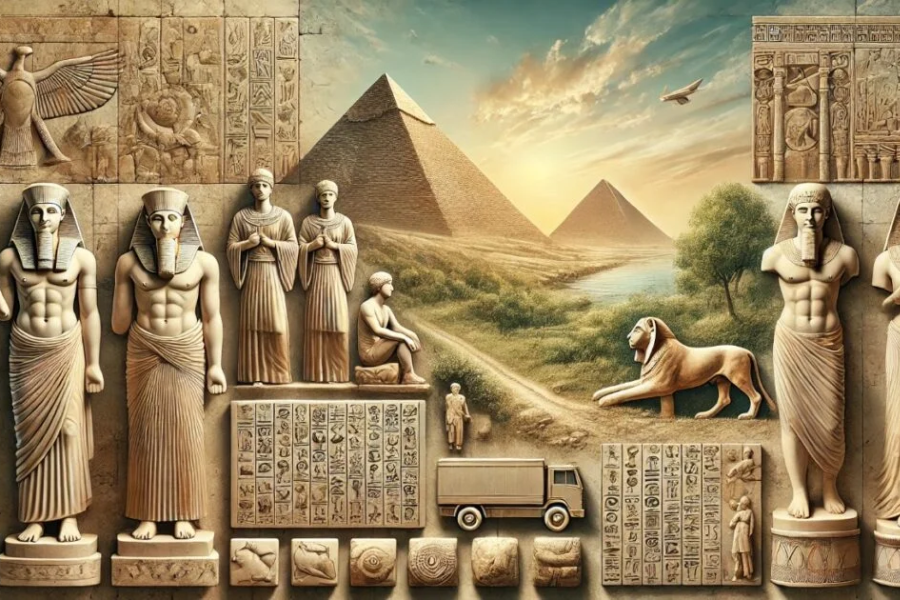Introduction
Art is a mirror of human culture, capturing the beliefs, values, and experiences that shape societies. Among the myriad forms of art that have emerged throughout history, ancient art stands out as a testament to our ancestors’ creativity and ingenuity. This article delves into the captivating world of ancient art, exploring its origins, styles, and enduring significance in human history.
1. Introduction to Ancient Art
Ancient art encompasses the artistic expressions of early human civilizations, spanning thousands of years and a wide array of mediums and styles. From prehistoric cave drawings to the intricate sculptures of ancient Greece and Rome, ancient art offers a window into the lives, beliefs, and values of our ancestors.
2. The Beginnings of Ancient Art
The roots of ancient art stretch back to prehistoric times, when early humans began to express themselves through drawings and carvings. These initial forms of art were often used for communication, storytelling, or religious purposes. As civilizations advanced, their artistic expressions became more sophisticated, leading to the development of distinct styles and techniques.
Prehistoric Art: The earliest known examples of ancient art are cave paintings found in locations such as the Lascaux Caves in France and the Altamira Caves in Spain. Dating back over 30,000 years, these paintings depict animals, hunting scenes, and abstract symbols, reflecting the close relationship between early humans and their environment.
Evolution of Ancient Art: As societies transitioned from nomadic to settled lifestyles, new forms of artistic expression emerged, including pottery, sculpture, and architecture. These early works laid the foundation for the diverse and complex art forms that would develop in ancient civilizations.
3. Key Styles of Ancient Art
Ancient art is characterized by its diversity, with each civilization developing its own unique style. Below are some of the most prominent ancient art styles from around the world.
Egyptian Art
Egyptian art is renowned for its distinctive style and rich use of symbolism. It was deeply connected to religion and the afterlife, with much of it created to honor the gods or ensure safe passage for the deceased into the next life.
- Hieroglyphics: A form of writing using symbols and images.
- Sculptures and Statues: Commonly depicting gods, pharaohs, and other important figures.
- Frescoes and Paintings: Found in tombs and temples, depicting scenes of daily life, religious rituals, and the afterlife.
Greek and Roman Art
Greek and Roman art are closely linked, with Roman art heavily influenced by earlier Greek styles. These civilizations are celebrated for their contributions to sculpture, architecture, and pottery.
- Greek Art:
- Sculpture: Focused on idealized human forms and proportions.
- Pottery: Featured vivid depictions of mythology and daily life.
- Architecture: Development of classical orders (Doric, Ionic, Corinthian).
- Roman Art:
- Sculpture: Emphasized realism and detailed portrayals of individuals.
- Mosaics: Complex images created from small pieces of stone or glass.
- Architecture: Innovations in arches, domes, and the use of concrete.
Chinese Art
Chinese art, one of the longest continuous artistic traditions, spans over 5,000 years. It is known for its emphasis on harmony, balance, and connection to nature.
- Calligraphy: Considered the highest art form in Chinese culture.
- Ink and Wash Painting: Simple and elegant depictions of landscapes, flowers, and birds.
- Ceramics: Including the famous blue and white porcelain.
Indian Art
Indian art is deeply spiritual and religious, with a rich history of sculpture, painting, and architecture that reflects the diverse cultural and religious traditions of the subcontinent.
- Sculpture: Depicts deities, mythological scenes, and symbols of spiritual significance.
- Temple Architecture: Highly ornate, featuring intricate carvings and elaborate designs.
- Miniature Paintings: Small, detailed works often depicting court scenes or religious themes.
4. Materials and Techniques in Ancient Art
The materials and techniques used in ancient art varied widely depending on the region and available resources. Below is a table summarizing some of the key materials and techniques employed by several ancient civilizations.
5. Themes and Symbolism in Ancient Art
Ancient artists frequently employed symbolism, using images and motifs to convey deeper meanings. Common themes in ancient art include religion, mythology, nature, and the human experience.
Common Themes:
- Religion and Spirituality: Many ancient artworks were created to honor deities or were used in religious ceremonies. Examples include Greek statues of gods and Egyptian tomb frescoes.
- Nature: Nature was a prevalent theme, with artists drawing inspiration from the world around them. This is evident in Chinese landscape paintings and Native American pottery featuring animal motifs.
- Human Experience: Ancient art often depicted scenes of everyday life, such as farming, hunting, and social gatherings, providing insight into the lifestyles of people in antiquity.
Symbolism:
- Chinese Art: Common symbols include the dragon (power and strength) and the phoenix (immortality).
- Egyptian Art: Symbols like the ankh (life) and the scarab beetle (rebirth) were widely used.
- Greek Art: Mythological figures and symbols, such as the laurel wreath (victory), were prevalent.
6. The Relevance of Ancient Art Today
Ancient art continues to influence modern art and culture, inspiring artists, architects, and designers. Many contemporary artistic traditions are rooted in techniques and styles developed by ancient civilizations.
Influence on Modern Art:
- Classical Revivals: The Renaissance marked a revival of Greek and Roman art, with artists like Michelangelo and Leonardo da Vinci drawing inspiration from ancient sculpture and architecture.
- Cultural Heritage: Ancient artifacts are vital components of cultural heritage. Preservation and study of these artworks have fostered renewed appreciation for the artistic achievements of early civilizations.
Ancient Art in Contemporary Design:
- Architecture: Modern buildings often incorporate elements of classical architecture, such as columns and arches.
- Fashion and Jewelry: Designers frequently draw from ancient art, incorporating motifs and styles from Egypt, Greece, and Rome into their creations.
- Visual Arts: Contemporary artists continue to explore themes and techniques from ancient art, creating works that honor the past while pushing the boundaries of modern art.
7. Preserving Ancient Art
Preserving ancient art is essential for understanding our history and cultural heritage. Over time, natural disasters, conflicts, and neglect have led to the loss or deterioration of many ancient artworks. However, ongoing efforts to conserve and restore these pieces help ensure that future generations can appreciate the beauty and significance of ancient art.
Challenges in Preservation:
- Environmental Factors: Exposure to sunlight, moisture, and temperature fluctuations can cause ancient artworks to deteriorate.
- Human Impact: Looting, vandalism, and improper handling have led to the destruction of numerous ancient artifacts.
- Technological Constraints: The materials and techniques used in ancient art can be difficult to preserve with modern methods.
Preservation Efforts:
- Restoration Projects: Many organizations and institutions work to restore ancient artworks, using advanced techniques to repair and stabilize them.
- Museums and Exhibitions: Museums play a crucial role in preserving and displaying ancient artifacts, providing controlled environments that protect them from deterioration.
- Education and Awareness: Promoting awareness about the importance of preserving ancient art is vital to ensuring that these works are safeguarded for future generations.
Facts
- Prehistoric Art: Includes cave paintings from sites like Lascaux and Altamira, dating over 30,000 years, depicting animals and abstract symbols.
- Egyptian Art: Known for its hieroglyphics, statues of gods and pharaohs, and frescoes found in tombs.
- Greek Art: Characterized by idealized human forms in sculpture, vivid pottery depictions, and classical architectural orders (Doric, Ionic, Corinthian).
- Roman Art: Emphasized realism in sculpture, developed mosaics, and innovations such as arches and domes.
- Chinese Art: Encompasses calligraphy, ink and wash painting, and renowned ceramics like blue and white porcelain.
- Indian Art: Includes detailed sculptures, ornate temple architecture, and miniature paintings reflecting diverse religious and cultural themes.
- Preservation Challenges: Ancient art is at risk from environmental factors, human impact, and technological constraints. Preservation efforts include restoration projects, museum conservation, and public education.
Summary
The article explores the rich and diverse world of ancient art, highlighting its significance as a reflection of human culture and creativity across different civilizations. It begins with an introduction to ancient art, covering its origins and evolution from prehistoric cave paintings to sophisticated works of art in ancient civilizations.
Key styles of ancient art are examined, including:
- Egyptian Art: Noted for its symbolism and connection to religion, with hieroglyphics, sculptures, and frescoes.
- Greek and Roman Art: Greek art is recognized for idealized sculptures, pottery, and classical architecture, while Roman art is known for realism, mosaics, and innovations in architecture.
- Chinese Art: Emphasizes harmony and nature through calligraphy, ink and wash painting, and ceramics.
- Indian Art: Features spiritual and religious themes in sculpture, temple architecture, and miniature paintings.
The article also discusses the materials and techniques used in ancient art, common themes and symbolism, and the enduring relevance of ancient art in modern times. It emphasizes the influence of ancient art on contemporary design and architecture and the importance of preserving ancient artworks through restoration, conservation, and education.
FAQs
Q1: What is ancient art?
A1: Ancient art refers to the artistic expressions of early human civilizations, spanning various mediums and styles, including cave paintings, sculptures, pottery, and architecture.
Q2: What are some examples of prehistoric art?
A2: Examples include the cave paintings at Lascaux and Altamira, which depict animals, hunting scenes, and abstract symbols.
Q3: How did Greek and Roman art differ?
A3: Greek art focused on idealized human forms and classical architecture, while Roman art emphasized realism, detailed portraits, mosaics, and architectural innovations such as arches and domes.
Q4: What are the main themes in ancient art?
A4: Common themes include religion and spirituality, nature, and human experience, often depicted through symbolic imagery and detailed scenes of daily life.
Q5: Why is preserving ancient art important?
A5: Preserving ancient art is crucial for understanding historical and cultural heritage. It ensures that future generations can appreciate and learn from these artistic achievements.
Q6: What are some common preservation challenges for ancient art?
A6: Challenges include damage from environmental factors (sunlight, moisture), human impact (looting, vandalism), and difficulties in using modern techniques for preserving ancient materials.
Q7: How can ancient art influence modern design and art?
A7: Ancient art influences modern design through classical architectural elements, fashion, jewelry, and visual arts, drawing inspiration from historical styles and themes.




